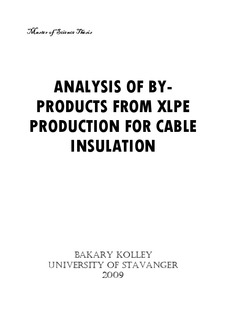| dc.description.abstract | Polyethylene is used in the manufacturing of cables. Because of the amount of high voltages which is transmitted through the cables at elevated temperatures, crosslinking of PE is necessary for stabilizing the insulation. This is done chemically by the addition of crosslinking agents such as dicumyl peroxide. This agent starts an autonomic process when subjected to heat after extrusion. However, crosslinking generates by-products which for dielectric, mechanical and electrical test and performance considerations need to be removed from the cables, thus the process of degassing. Degassing or thermal treatment is an important process with cable manufacturing. After thermal treatments on the material XLPE different analytical techniques can be applied to measure the progress of degassing.
Analysis of XLPE cables is essential in order to determine the contents of by-products after crosslinking and degassing. Many analytical methods such as TGA, DSC, GC-MS, HPLC, FT-IR, TL and EL are used to conduct these measurements. In this project, after looking at the chemical and the physical characteristics of the interesting components of XLPE, HPLC with a UV detector was found to be best suited to carry out quantitative and qualitative analysis. This required an analytical method to be developed. An ideal wavelength of 250 nm, a buffer solution of pH 2.3 made of nano pure water and formic acid, a C 18 column and a gradient mobile phase were found to be good instrumentation settings.
Reproducibility was obtained with regards to how standard analytes appear in the chromatogram singularly and in mixed solutions. In the quantitative analysis, calibration curves were derived from data produced by standard samples. The same calibration curves were used to determine the concentrations of acetophenone, alpha cumylalcohol, alpha methylstyrene and dicumyl peroxide in both degassed and not-degassed XLPE samples. Degassing has also been carried out in the lab, in a chamber, at a fixed temperature of 70 ºC and varying times. Results have shown that the more time a sample has been degassed, the lesser the concentrations of analytes to be determined. Weight loss, a simple test for degassing, has been observed in all the cables that underwent thermal treatment. | no_NO |
